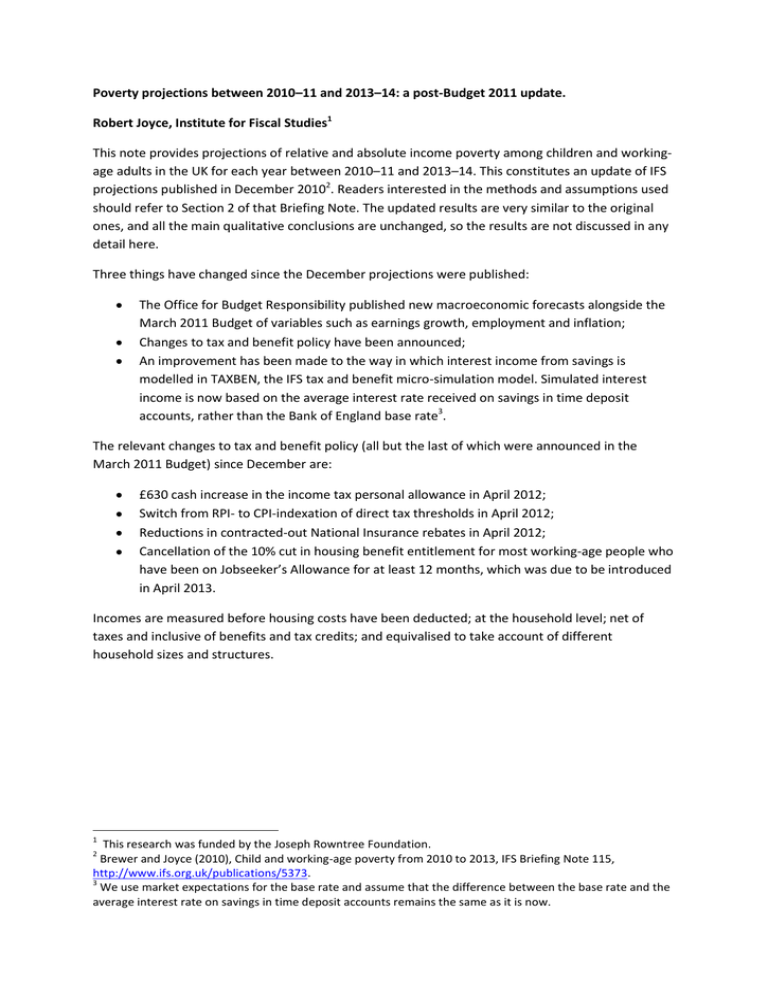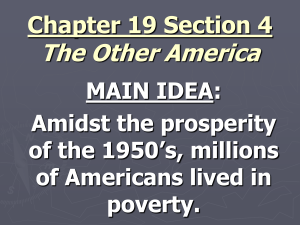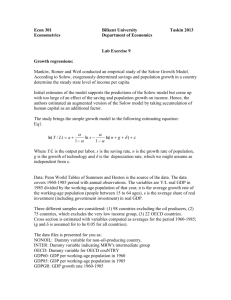Poverty projections between 2010–11 and 2013–14: a post-Budget 2011 update.
advertisement

Poverty projections between 2010–11 and 2013–14: a post-Budget 2011 update. Robert Joyce, Institute for Fiscal Studies1 This note provides projections of relative and absolute income poverty among children and workingage adults in the UK for each year between 2010–11 and 2013–14. This constitutes an update of IFS projections published in December 20102. Readers interested in the methods and assumptions used should refer to Section 2 of that Briefing Note. The updated results are very similar to the original ones, and all the main qualitative conclusions are unchanged, so the results are not discussed in any detail here. Three things have changed since the December projections were published: The Office for Budget Responsibility published new macroeconomic forecasts alongside the March 2011 Budget of variables such as earnings growth, employment and inflation; Changes to tax and benefit policy have been announced; An improvement has been made to the way in which interest income from savings is modelled in TAXBEN, the IFS tax and benefit micro-simulation model. Simulated interest income is now based on the average interest rate received on savings in time deposit accounts, rather than the Bank of England base rate3. The relevant changes to tax and benefit policy (all but the last of which were announced in the March 2011 Budget) since December are: £630 cash increase in the income tax personal allowance in April 2012; Switch from RPI- to CPI-indexation of direct tax thresholds in April 2012; Reductions in contracted-out National Insurance rebates in April 2012; Cancellation of the 10% cut in housing benefit entitlement for most working-age people who have been on Jobseeker’s Allowance for at least 12 months, which was due to be introduced in April 2013. Incomes are measured before housing costs have been deducted; at the household level; net of taxes and inclusive of benefits and tax credits; and equivalised to take account of different household sizes and structures. 1 This research was funded by the Joseph Rowntree Foundation. Brewer and Joyce (2010), Child and working-age poverty from 2010 to 2013, IFS Briefing Note 115, http://www.ifs.org.uk/publications/5373. 3 We use market expectations for the base rate and assume that the difference between the base rate and the average interest rate on savings in time deposit accounts remains the same as it is now. 2 Results Tables 1 and 2 show poverty forecasts under current policies for children, working-age adults, working-age parents, and working-age adults without children. The impact on these forecasts of the tax and benefit policy changes announced in the March 2011 Budget has been negligible. Tables 3 and 4 show estimates of the impact on these forecasts of all modelled tax and benefit reforms announced by the coalition Government (see Section 2.3 in Brewer and Joyce (2010)4 for a list of reforms that we do not model, because we do not think that their impact can be allocated precisely enough to particular households). This analysis is done using the same key assumptions as HM Treasury in its modelling of the impact of the coalition Government’s tax and benefit reforms on child poverty: specifically, no behavioural responses nor impacts on pre-tax prices are assumed, and the macroeconomic environment is taken as given (i.e. not affected by the coalition Government’s reforms). In the March 2011 Budget, HM Treasury claimed that “The Government’s modelled tax and welfare reforms, including the measures announced today, could reduce child poverty by up to 50,000 over the next two years”5. Table 3 shows that our central estimate differs from this, suggesting a small child poverty-increasing impact of the Government’s reforms in 2012–13. As in December, a key reason for this discrepancy is the fact that we have modelled reforms to Local Housing Allowance, whereas the Treasury has not. 4 http://www.ifs.org.uk/publications/5373. See page 40 of the 2011 Budget: http://cdn.hm-treasury.gov.uk/2011budget_complete.pdf. 5 Table 1. Projections of relative income poverty in the UK under current policies Children Working-age adults Working-age parents Working-age adults without children Millions % Millions % Millions % Millions % Real annual median income growth (%) 2008 (actual) 2.8 21.8 5.8 16.0 2.4 18.2 3.4 14.7 – 2010 2.6 19.9 5.7 15.6 2.2 17.0 3.5 14.8 -1.1 2011 2.7 20.3 5.8 15.8 2.3 17.4 3.6 14.9 -2.1 2012 2.7 20.8 6.1 16.4 2.3 18.0 3.8 15.5 -0.2 2013 2.9 21.9 6.4 17.0 2.5 18.8 4.0 16.0 +0.1 Notes: Incomes measured before housing costs have been deducted. Poverty line is 60% of median income. Years refer to financial years. Real annual median income growth for 2010 is projected average annual median income growth between 2008 and 2010. Source: Authors’ calculations based on Family Resources Survey 2008–09 using TAXBEN and assumptions specified in http://www.ifs.org.uk/publications/5373. Table 2. Projections of absolute income poverty in the UK under current policies Children Working-age adults Working-age parents Working-age adults without children Millions % Millions % Millions % Millions % 2008 (actual) 2.6 20.4 5.5 15.3 2.2 17.2 3.3 14.1 2010 2.6 19.9 5.7 15.6 2.2 17.0 3.5 14.8 2011 2.8 21.7 6.1 16.5 2.4 18.6 3.7 15.3 2012 2.9 22.4 6.4 17.1 2.5 19.2 3.9 16.0 2013 3.1 23.2 6.7 17.7 2.6 19.9 4.1 16.6 Notes: Incomes measured before housing costs have been deducted. Poverty line is 60% of the real 2010–11 median income (hence, relative and absolute poverty in 2010–11 are identical). Years refer to financial years. Source: As for Table 1. Table 3. Estimated impact on relative poverty of coalition Government tax and benefit reforms Children Working-age adults Working-age parents Working-age adults without children Millions % Millions % Millions % Millions % Impact on median income (%) 2011 +0.1 +0.5 +0.1 +0.2 +0.1 +0.4 +0.0 +0.0 +0.4 2012 +0.2 +1.4 +0.3 +0.9 +0.2 +1.3 +0.2 +0.7 -0.3 2013 +0.2 +1.7 +0.4 +1.2 +0.2 +1.5 +0.2 +1.0 -1.1 Notes: Incomes measured before housing costs have been deducted. Poverty line is 60% of median income. Years refer to financial years. Source: As for Table 1. Table 4. Estimated impact on absolute poverty of coalition Government tax and benefit reforms Children Working-age adults Working-age parents Working-age adults without children Millions % Millions % Millions % Millions % 2011 +0.1 +0.0 -0.0 -0.1 +0.0 +0.1 -0.1 -0.2 2012 +0.2 +1.4 +0.3 +0.8 +0.2 +1.2 +0.1 +0.5 2013 +0.3 +2.2 +0.6 +1.5 +0.2 +1.9 +0.3 +1.3 Notes: Incomes measured before housing costs have been deducted. Poverty line is 60% of the real 2010–11 median income. Years refer to financial years. Source: As for Table 1.





